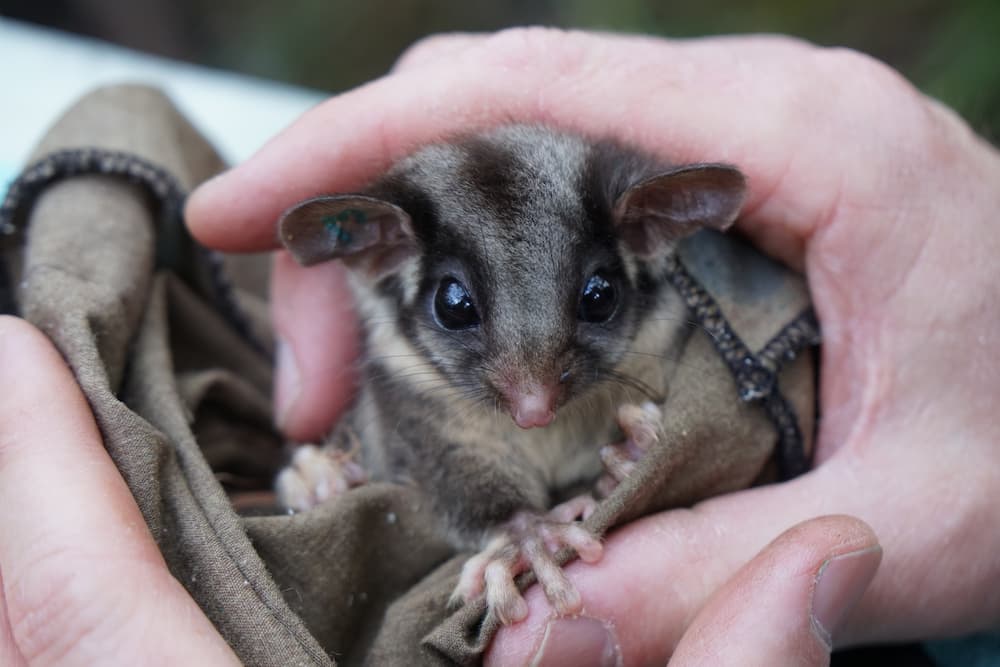Species Information
The Leadbeater’s Possum is a small, quick and elusive marsupial. They were thought be extinct until their rediscovery near Marysville in 1961. They are now one of Victoria’s state Faunal Emblems. A very small lowland population is found only in Yellingbo Nature Conservation Reserve, alongside our other Faunal Emblem species, the Helmeted Honeyeater. Highland populations of Leadbeater’s possums are found further east, in the tall, wet forests of Victoria’s Central Highlands.
These possums rely on tree hollows, in which small colonies of up to 12 will sleep together. Colonies have one monogamous breeding pair, that may produce up to two young each year. Leadbeater’s society is very territorial and matriarchal. The female is aggressive and will expel outsiders and younger females from the group.
Leadbeater’s build large intricate shredded back nests in multiple hollows across their territory. They are known as ‘forest fairies’ as they flit and dart across the tree tops at night searching for food. Possums emerge from their nests at dusk to forage through the sub canopy, leaping from tree to tree to search for food. They feed on wattle sap, lerps and insects, which they find hiding under loose bark on eucalypt trees.

Credit: Zoos Victoria
Threats
The lowland population of the Leadbeater's Possum can only be found at Yellingbo Nature Conservation Reserve and is an Evolutionary Significant Unit (ESU), genetically different from the highlands Leadbeater’s populations. Because these possums live in just one location and in such a small, isolated pocket of habitat, they are particularly vulnerable. As the floodplain habitat deteriorates in Yellingbo, the number of colonies has reduced dramatically over the past 20 years. Hydrology is the driving factor in this population decline.
In addition to habitat quality being reduced by altered hydrology, habitat is also being destroyed by browsing animals such as deer, and climate change is an ongoing threat.
Habitat protection and restoration is required to support the lowland Leadbeater's Possums with the efforts having a combined benefit for Leadbeater’s and Helmeted Honeyeaters, who occupy the same habitat in the reserve.
The highland population of the Leadbeater's Possum lives primarily in the ash forests and sub-alpine woodlands of Victoria's Central Highlands. Bushfires and the ongoing loss of hollow bearing trees through decay are the greatest threats to the highland Leadbeater's Possum populations, while timber harvesting results in younger, even-aged forests lacking the hollows needed for breeding.
What's being done?
The Victorian Government has implemented all 13 recommendations made by the Leadbeater’s Possum Advisory Group (LPAG) in 2014 to support the recovery of the species while maintaining a sustainable timber industry. Actions included targeted surveys, establishment of timber harvesting exclusion zones, enhanced bushfire protection, installation of nest boxes in key locations, research into artificial hollow development and implementation of regrowth retention harvesting in ash forests. In total, the Victorian Government invested $11,000,000 towards these actions.
Efforts to save the species are being supported by a $200,000 grant through the Victorian Government’s Biodiversity On-Ground Action Icon Species Grants program, which funds targeted actions designed to protect and conserve Victoria’s threatened species. This funding is being used to protect critical habitat of the lowland Leadbeater's Possum, and work towards restoring hydrological conditions at Yellingbo Nature Conservation Reserve, the only place lowland Leadbeater's Possums can be found.
The Victorian Government has provided additional support through the Caring for Our Environment- Faunal Emblems Program. This program is providing $3,000,000 over two years to help Helmeted Honeyeater’s and Leadbeater’s Possums (highland and lowland). This funding has been provided to a suite of partners to assist the survival of these species.
Actions include:
- Habitat protection and restoration
- Species monitoring
- Genetic research
- Pest species control
- Disease and health assessments
- Advancements in captive breeding
Leadbeater's Possums are protected by a 'prescription' guarding against timber harvesting under the Code of Practice for Timber Production. More information can be found through the Forest Protection Survey Program.
Volunteer and community groups have been an important part of Leadbeater's conservation efforts by conducting surveys to search for new colonies. Leadbeater's Possum survey kits, and training are available from DELWP. See our Wildlife page for ways you can become involved.
Zoos Victoria hold a small captive population at Healesville Sanctuary.
Who's helping
Conserving Victoria's threatened species requires a collaborative approach. There are a number of organisations working to help with the protection and recovery of Leadbeater's Possum. These include:
Page last updated: 19/05/22